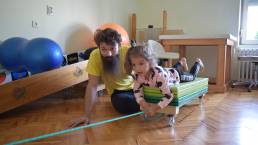Ayres method
Some problems, such as rash, broken bones or bad eyesight are visible; others, such as learning disabilities or bad behaviour are not.
Slower learning or bad behaviour can be the result of inadequate sensory integration in the child's brain.
How do you recognize if your child is potentially showing “poor” sensory integration?
The behavior of a child with SI disorder is divided into three general groups:

Insufficiently sensitive/hyposensitive
(seems like his muscles are weak, has a weak grip, can’t lift heavy objects, often leans to maintain his posture, seems to lack energy, prone to injuries and accidents, takes too many risks when playing, can’t interpret body language or facial expressions…)
Oversensitive/Hypersensitive (holds hands over his ears to protect himself against relatively “harmless” sounds, is bothered by or turns away from bright light, often withdraws from group activities and stands in the corner, dislikes activities where his head is bent down like forward rolls, avoids playground objects or toys that move – swings, seesaws, doesn’t like to get dirty….)
Combination of hypo and hyper sensitivity
AYRES METHOD
If you notice any of these symptoms in your child, it does not necessarily mean that he has a direct problem with sensory processing. Each child is an individual, and for this reason, detailed assessment and creation of a sensory profile is used to check whether there is need for sensory integration treatment.
This treatment requires a specially equipped room that contains all the “challenges” that the child will encounter and learn to self-regulate, with carefully planned interventions by the therapist. The treatment targets all the visible problems that a therapist notices during their assessment of the child, but also those based on the information they receive from the family and other people close to the child. It is very important that the goals of the parents and the therapist match, because, in addition to the treatment that is carried out in an appropriate sensory room, parents are given advice about how to deal with their child in his natural environment – home, school, playground…